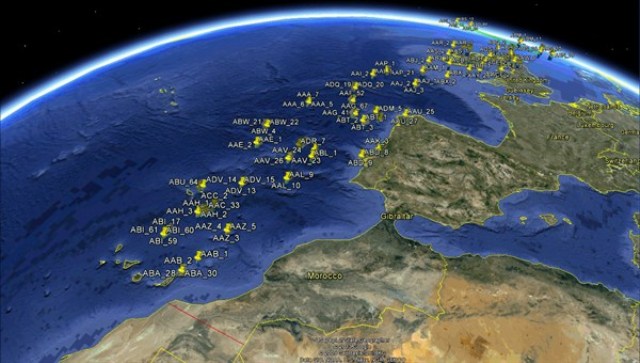Jun 14 2013
An A320 overflying Scotland was the first aircraft 'seen' from space by a new receiver from the German Aerospace Centre (Deutsches Zentrum für Luft- und Raumfahrt; DLR), proving that tracking aircraft from space is possible.
 Tracking aircraft over Great Britain
Tracking aircraft over Great Britain
The ESA Proba-V satellite has been in Earth orbit since 7 May 2013; its payload includes a dedicated receiver to pick up aircraft ADS-B signals (Automatic Dependant Surveillance Broadcast). On 23 May the experiment was switched on for the first time, recording over 12,000 ADS-B messages within two hours, at an altitude of 820 kilometres.
"Worldwide, this is the first experiment ever of this kind – and now we have evidence that this concept works," says DLR Project Manager Toni Delovski. The project team detected over 100 aircraft during the first pass over the British Isles, East Asia and Australia when the receiver was switched on. "For some aircraft, we were able to determine multiple positions over time, which allowed us to reconstruct their flight paths."
ADS-B signals are broadcast by aircraft every second; they include aircraft position and velocity information. ADS-B equipment is being introduced on aircraft as a supplementary data source to the ground-based radar currently used to monitor air traffic. The problem with radar is that its coverage is restricted. Once out of the range of terrestrial radar stations, the continuous air traffic surveillance stops. "For example, aircraft travelling from Europe to Brazil disappear from the radar over the Atlantic and will only be detected again by terrestrial radar shortly before reaching South America," explains Delovski.
There is currently no continuous air traffic surveillance by terrestrial radar over oceanic airspace or in regions with limited air traffic surveillance infrastructure. But tracking from space could close this gap. 'ADS-B over satellite' is a joint project of the DLR Institute of Space Systems and the DLR institute of Flight Guidance, in cooperation with the Luxembourg partner SES TechCom Services.
Tracking from space
DLR developed the experiment for the satellite while SES TechCom developed the data segment, with ESA providing it an early trial in space on board Proba-V. The receiver had previously been flown on a stratospheric balloon, with successful results. Additional computer modelling reassured the scientists: "But models are no substitute for actual flight experience," adds Delovski. “There are influencing variables in space which one does not know well."
From an altitude of 820 kilometres, the system has passed this practical test, returning its first results. Now, the DLR researchers will begin extensive data analysis. "We will now determine how sensitively our receiver has detected aircraft from space," says Delovski. Although the system might later be used in regions without terrestrial radar stations, it is these regions that the scientists have to rely on at the beginning – only the comparison with aircraft detected from the ground will show how well DLR's receiver is performing on board the satellite.
Which aircraft were detected? Are there regions where the receiver in space has only limited reception? What types of signals does it receive? Once the receiver's performance has been analysed, the DLR researchers will know how well the receiver is likely to perform in regions without ground stations. "This is where our space system would really come into its own," says division head Jörg Behrens. "With this tracking from a satellite, flight paths might, for example, be planned more efficiently and aircraft could fly with smaller separation distances in regions without radar surveillance."